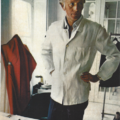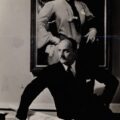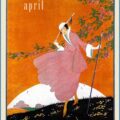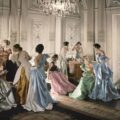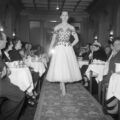Womens fashion 1918 – weddings
May 29, 2016Speaking of Womens fashion 1918 and weddings, this is a wedding, or perhaps evening, perhaps both dress by Lucile from November 1918. It is fashionably layered, with a strip of, you’ll have to use your imagination a bit here or peer closely, but that is a strip of silver and white brocade at the top. Unfortunately the silver thread, which would be real silver, has tarnished and is too delicate to clean. But see for yourself, because the dress is currently available at auction for what seems the amazingly reasonable price of £600-£1,000.
Womens fashion 1918 – weddings
On top of the brocade is ecru lace with silver sequins and the main part of the dress is ivory silk-satin. The design is very loose as was the coming fashion in womens fashion 1918, daringly asymmetric, and the long length indicative of its formal purpose. If it was bought for a wedding, it may well have been worn again for a presentation at court or as evening dress, because in the war years luxurious fabrics like these were a bit hard to get hold of.
These wedding dress designs are from a year later, 1919. All the drawings are from from the same designer-maker, Elizabeth Handley Seymour, who later went on to design and create both the wedding dress and coronation dress for Elizabeth Bowes Lyon, the Duchess of York – you might know her better as the Queen Mother.
Womens fashion 1918 – skilled copyists
But the shocker is that this court designer didn’t necessarily think up the all outfits she has in her design books. Some of these drawings are of works by other great couturiers of the time – The House of Worth, Callot Soeurs or Paul Poiret, mixed in with her own ideas.
This was common practice at the time, when even very rich members of society might have a copy of a desirable gown made, sometimes in exactly the same fabric and trimmings as the original designer. It was illegal, then as it is now. So, bad news for the designers of the time, but good news for us since these seven drawings represent quite a range of bridal styles popular in womens fashion 1918.
Womens fashion 1918 – inspired by top designers
So here is a “Russian Inspired” wedding dress, very loose and heavily beaded, looking at the Ballet Russe inspired work of Paul Poiret. The pretty embroidered tulle overlay on top of silver tissue could have been a Jeanne Lanvin, and the ones with simple square necklines Edward Molyneux. I’m not sure about the toga inspired one, maybe Jeanne Paquin as she was really fond of the dressing up box!
It has to be understood that Handley Seymour wasn’t trying to pass these designs off as her own, the designs would have been marked with the original designer’s name and the client would be looking for a slice of real French couture, only at less elevated prices. Mrs Handley Seymour would have allowed them to borrow a few different sketches for a few days in order to decide what they wanted with a charge if they didn’t return them.
Wedding dress colours
White and its cousins ivory, cream and oyster were popular colours for wedding dresses in womens fashion 1918, with also pale pink, gold and silver as shown here and in the Lucille design. High fashion was about layers or contrasts – chiffon over or next to brocade, floaty georgette edged in heavy fur, shimmering taffetas and embroidered silks. The often bright or jewel colours of evening gowns – deep turquoise with an overlay of peacock blue, electric blue next to brown fur – were toned down for wedding gowns with pretty shell pink overlaid with silver net, or silver lame covered in an ivory chiffon embroidered with deep pink rosebuds.
Womens fashion 1918 – a lavish show
At the beginning of the war, it was seen as patriotic for society brides to put on a lavish show at their weddings and dress well, to keep spirits up and show that Britain was unaffected by events. But by the end of the war it was the opposite, and seen as supporting you country to be a bit more frugal. In 1914, etiquette guides recommended that “no more than ten bridesmaids” was the tasteful option. By the end of the war just two were recommended. As well as this, by the end of the war the traditional throwing of rice as confetti was seen as a shocking waste of food, and banned by law.
Womens fashion 1918 – multi purpose gowns
As 1918 was near the end of the war, even these very expensive and purpose made wedding dresses were often intended with several purposes, such as to be worn again at court or slightly re-modelled with the sleeves and train removed to make evening dresses.
Practical wedding dresses
It had been the case for a long time that many wedding dresses of the working classes weren’t purpose made but just the normal Sunday Best, or if they had been purpose made, it was with the idea of them swiftly becoming Sunday Best soon afterwards. They would often have chosen a dress that wasn’t conspicuously “Wedding-y”, in order for it to have plenty of mileage.
But now this effect was extending to all classes, and those who would normally have planned their happy event for months or even years were forced to forgo the luxury of both time and money.
Womens fashion 1918 – Vogue’s opinion
“As almost everyone nowadays is marrying as well as dressing on a war income, the war bride will probably turn first to pages 56 and 57, where the problem is discussed in all its delightful details. Nothing, you see, goes to the head quite so quickly and completely as a prospective wedding, and no single event in life provides so many temptations to extravagance. An adequate trousseau may, and should be, as seductive as you please. No easy matter this as her wedding is the great event in a girls’ life, and no less so if she is marrying in haste without an opportunity to shop at leisure.” Vogue May 1918.
Womens fashion 1918 – heightened emotions
The urge to make haste and marry a man who in some cases was barely known is quite easy to understand – emotions were heightened and it was encouraged in the national press, in order to give the soldiers some “comfort” before leaving. The image of his dear darling wife waiting at home for him whilst he fought in the trenches of another land may indeed have given him some comfort, or perhaps it was the memory of his wedding night which did that.
Sex before marriage was still frowned upon, and sometime couples didn’t want to wait when they felt they may not see each other again. Or perhaps they hadn’t quite waited, and wanted their forthcoming child to be born within wedlock. If the worst happened, the wife was entitled to a (meagre) war widow’s pension from the government, so there was also some pecuniary advantage to getting married quickly. In fact, some couples did decide to live in sin, and the government was later persuaded to give these unmarried partners of servicemen an allowance too.
Womens fashion 1918 – marriage in a suit
Sometimes this rush was very rushed indeed, as a serviceman would come home unexpectedly from training, announce he was leaving old Blighty the day after tomorrow and therefore could marry “next morning any time between eleven and two”, according to Vogue.
This meant that society and working class women alike sometimes found themselves marrying in a smart suit, (or costume as it was called), enlivened with a nice piece of jewellery, sometimes borrowed for the occasion. They may have found time to rush out and buy a new hat for the occasion. The gift from the groom to the bride was often the flowers that she would carry – a sheaf of lilies or bunch of roses. The groom was usually dressed in his regimental uniform.
Womens fashion 1918 – khaki lovers
Some of the marriages of these “khaki lovers” were both rushed and right on the battle front as it was for the much reported on union of Elsie Knocker, the famous nurse, and her dashing beau the Baron Harold T’Serclaes, a Belgian Flying Corps pilot. Elsie struggled out of her own nurse’s uniform or the more familiar khakis she wore as an ambulance driver to dress in a navy blue crepe de Chine dress with a big black velvet hat, and a nice warm musquash fur coat.
Although the bride herself didn’t usually marry in uniform, there are some reports of the guard of honour being formed by uniformed police women, or even of the bridesmaids sticking to their land girl outfits.
Trench Weddings
These “Trench Weddings” made a nice story for the press and were seized upon as some happy news amid the increasing death toll.
But the reality, away from the press was sometimes different. Those that survived came home after an enforced absence of several years in some cases. Without the romance and urgency of war, the marriage didn’t last long once civilian life resumed and that dashing pilot went back to being a bank clerk, and the independent Munionette or land girl found herself in the role of the sock-washing wife.
Two of the dresses as they look in the album.
Lucile Weddding gown 1918, image Kerry Taylor Auctions
Lucile Weddding gown 1918 back detail, image Kerry Taylor Auctions
Lucile Weddding gown 1918 back, image Kerry Taylor Auctions
1919 White wedding dress design with square neckline and pointed hemline by Elizabeth Handley Seymour.
1919 Wedding dress design. Bodice of gold lamé and white, swathed with a toga drape in gold-patterned white brocade and a long train by Elizabeth Handley Seymour.
1919 Wedding dress design, white with figured gold design, long square train and draped skirt by Elizabeth Handley Seymour.
Simple white wedding dress design for 1919 with long tight sleeves and straight cut body, long train by Elizabeth Handley Seymour.
1919 design for Silver lamé tissue wedding dress overlaid with tulle, pink rosebud trimming by Elizabeth Handley Seymour.
1919 design for Russian-inspired wedding dress with beaded tunic and kokoshnik headdress by Elizabeth Handley Seymour.






